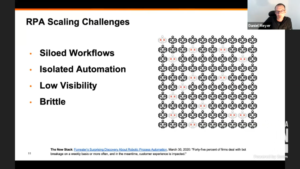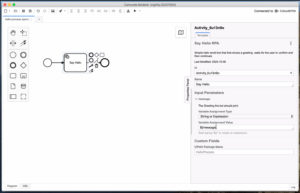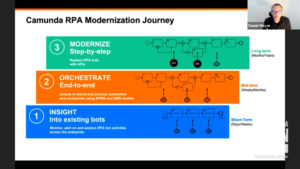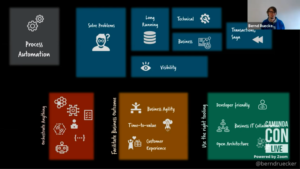I’m back at CamundaCon 2020.2 for day 2, which kicked off with a keynote by Camunda co-founder and developer advocate Bernd Rücker. He’s a big fan of BPM and graphical models (obviously), but not of low-code: his view is that the best way to build robust process-based applications is with a stateful workflow engine, a graphical process modeler, and code. In my opinion, he’s not wrong for complex core applications, although I believe there are a lot of use cases for low code, too. He covered a number of different implementation architectures and patterns with their strengths and weaknesses, especially different types of event-driven architectures and how they are best combined with workflow systems. You can see the same concepts covered in some of his previous presentations, although every time I hear him give a presentation, there are some interesting new ideas. He’s currently writing a book call Practical Process Automation, which appears to be gathering many of these ideas together.

CTO Daniel Meyer was up next with details of the upcoming 7.14 release, particularly the RPA integration that they are releasing. He positions Camunda as having the ability to orchestrate any type of process, which may include endpoints (i.e., non-Camunda components for task execution) ranging from human work to microservices to RPA bots. Daniel and I have had a number of conversations about the future of different technologies, and although we have some disagreements, we are in agreement that RPA is an interim technology: it’s a stop-gap for integrating systems that don’t have APIs. RPA tends to be brittle, as pointed out by Camunda customer Goldman Sachs at the CamundaCon Live earlier this year, with a tendency to fail when anything in the environment changes, and no proper state maintained when failures occur. Daniel included a quote from a Forrester report that claims that 45% of organizations using RPA deal with breakage on at least a weekly basis.
As legacy systems are replaced, or APIs created for them, RPA bots will gradually be replaced as the IT infrastructure is modernized. In the meantime, however, we need to deal with RPA bots and limit the technical debt of converting the bots in the future when APIs are available. Camunda’s solution is to orchestrate the bots as external tasks; my advice would also be to refactor the bots to push as much process and decision logic as possible into the Camunda engine, leaving only the integration/screen scraping capabilities in the bots, which would further reduce the future effort required to replace them with APIs. This would require that RPA low-code developers learn some of the Camunda process and decision modeling, but this is done in the graphical modelers and would be a reasonable fit with their skills.

The new release includes task templates for adding RPA bots to processes in the modeler, plus an RPA bridge service that connects to the UiPath orchestrator, which in turn manages UiPath bots. Camunda will (I assume) extend their bridge to integrate with other RPA vendors’ orchestrators in the future, such as Automation Anywhere and Blue Prism. What’s interesting, however, is that the current architecture of this is that the RPA task in a process is an external task — a task that relies on an external agent to poll for work, rather than invoking a service call directly — then the Camunda RPA bridge invokes the RPA vendor’s orchestrator, then the RPA bots poll their own orchestrator. If you are using a different RPA platform, especially one that doesn’t have an orchestrator, you could configure the bots to poll Camunda directly at the external task endpoint. In short, although the 7.14 release will add some capabilities that make this easier (for enterprise customers only), especially if you’re using UiPath, you should be able to do this already with any RPA product and external tasks in Camunda.

Daniel laid out a modernization journey for companies with an existing army of bots: first, add in monitoring of the bot activities using Camunda Optimize, which now has the capability to monitor external events, in order to gain insights into the existing bot activities across the organization. Then, orchestrate the bots using the Camunda workflow engine (both BPMN and DMN models) using the tools and techniques described above. Lastly, as API replacements become available for bots, switch them out, which could require some refactoring of the Camunda models. There will likely be some bots left hanging around for legacy systems that are never going to have APIs, but that number should dwindle over the years.
Daniel also teased some of the “smart low-code” capabilities that are on the Camunda roadmap, which will covered in more detail later by Rick Weinberg, since support for RPA low-code developers is going to push them further into this territory. They’re probably never going to be a low-code platform, but are becoming more inclusive for low-code developers to perform certain tasks within a Camunda implementation, while professional developers are still there for most of the application development.
This is getting a bit long, so I’m going to publish this and start a new post for later sessions. On a technical note, the conference platform is a bit wonky on a mobile browser (Chrome on iPad); although it’s “powered by Zoom”, it appears in the browser as an embedded Vimeo window that sometimes just doesn’t load. Also, the screen resolution appears to be much lower than at the previous CamundaCon, with the embedded video settings maxing out at 720p: if you compare some of my screen shots from the two different conferences, the earlier ones are higher resolution, making them much more readable for smaller text and demos. In both cases, I was mostly watching and screen capping on iPad.



Hi Sandy,
Thanks for the thoughtful coverage of CamundaCon Live (and other conferences)!
In the interest of shared learning for others reading your posts, I’m responding to some of your comments on the platform we used for the conference. This is some of the secret sauce behind running a large digital event! 🙂
No platform is perfect. While On24 was great in April, it did have challenges with certain operating systems and browsers. Especially running technical demos on linux were not ideal and had to be recreated on Windows or Mac environments. There were other limitations as well.
For this October event we wanted to use Zoom but had to get around certain challenges there. e.g. For compliance and privacy reasons Zoom cannot be used by audience members in certain industries (banking/insurance). Our way around that was to stream the conference using Vimeo. YouTube was an option but they serve up ads and our desire was to provide a distraction-free experience.
As for the 720p vs 1080p HD – this was a limitation from Zoom. Given the current volumes they are experiencing due to Covid-19, they are not supporting any new customers with HD video. We’re still working with them to get support for true HD video.
When it comes to the videos not loading, we did not run into a lot of feedback around that. So I don’t have a lot of data around that. In all our testing and almost no feedback around downtime in the slack channel – this needs further investigation.
We’re always looking to improve and hopefully we’ll be able to enhance the experience of Camundacon Live with one of these platforms. Thanks again for your support!
Agreed that no platform is perfect. Good job nonetheless.